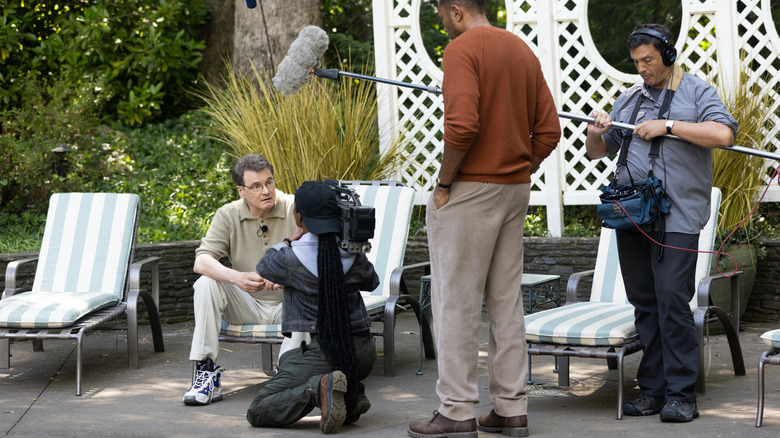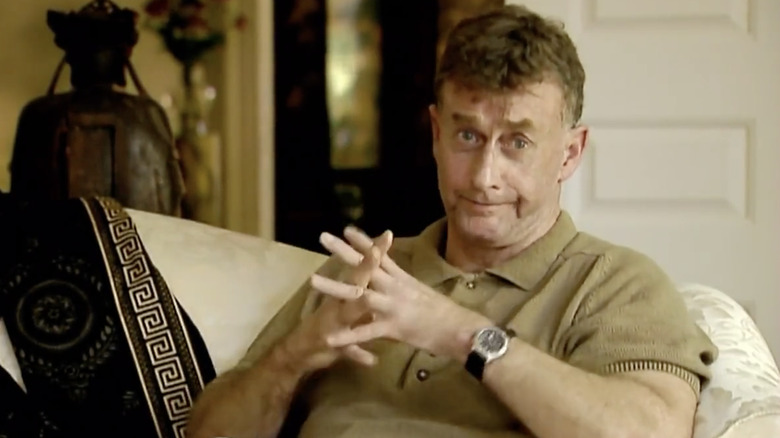The Staircase Went To The Real Crime Scene To Create Its Sets
As a culture, we've always been obsessed with true crime. Back in 1970, the public devoured every grizzly detail of the Manson murders, right down to the bloody writing on the walls, and the whole case became a spectacle. America couldn't tear its eyes away from the weirdo cult leader and his gang of acid-tripping misfits. The murderers became stars of their own television shows. Now, they get a series.
One of the most recent murders to capture the attention of true crime enthusiasts and television audiences is that of Kathleen Peterson. On December 9, 2001, Michael Peterson called 911 stating that his wife, Kathleen, had fallen down the stairs of their North Carolina home. When police arrived, the blood-covered crime scene told a very different story. Shortly after Kathleen's death, her husband was arrested and accused of first-degree murder. The resulting trial would unearth salacious details of Micheal's private life and divide a family.
It was perfect for television, and resulted in a docu-series called "The Staircase." On May 5, 2022, HBO Max released their own "The Staircase," a dramatized version of the events surrounding Peterson's death and the resulting murder trial. After visiting the real crime scene, the crew was able to replicate the staircase and the blood that was on it the night Kathleen Peterson died.
Fair warning, there are "Staircase" spoilers ahead!
Documenting murder
Before the HBO Max series, a French filmmaker, Jean-Xavier de Lestrade created an award-winning documentary series about the Peterson trial, also called "The Staircase." The series offers an inside look at Michael Peterson's life as he is tried, convicted, and imprisoned for the murder of his wife.
Throughout the program, Michael continues to profess his innocence, claiming Kathleen was his "soulmate." As more details are revealed, including financial trouble and evidence of Michael's affairs with men, his innocence becomes harder to believe. Things get worse for him when his sisters-in-law and Kathleen's biological daughter, suspect him of the crime and join the prosecution's side. In the documentary, all of this plays out in real-time and we're allowed a front-row seat.
With such an open and honest look at every detail of Peterson's life and home, it was important to make the HBO Max series unique. In order to do this, production designer Michael Shaw treated the events as if they were fictional:
"I wanted to read the episodes and interpret it as if it wasn't a real event. It was important to create something that wasn't a replica of the doc."
This meant changing small details of the family home, but one very important thing would stay the same. The staircase and blood spatter would be exact replicas of the actual crime scene.
Replicating the staircase
The real staircase was a huge part of the crime, so Shaw knew he had to have an exact match in the series. More accurately, the crew had to build three replicas for filming different scenes. One was kept pristine for shots before Kathleen's murder, one was covered in blood for post-murder scenes, and one was padded and covered with green fabric for stunt and special effects work.
I know zilch about carpentry, but I can imagine how hard it would be to build an exact replica of stairs from pictures. Luckily, the series had a lot better source material to work from. According to showrunner Maggie Cohn, the Peterson house was up for sale during production of the series, and the crew was allowed inside to take measurements of the famed staircase.
The next problem the series had to tackle was the blood spatter around the staircase. Anyone who has ever tuned into an episode of CSI knows that the placement of blood is important evidence at a crime scene. Trained experts can use the patterns to identify a victim's position when they were attacked, how hard they were hit, etc., so Shaw felt it was important to get the pattern right. He gave that job to the on-set scenic artist, Tammie Trimble:
"[She] became kind of a blood-splatter shaman. We gave her the set, and she closed herself off for about five days and would look at pictures of Kathleen and play whatever music moved her. Nobody could go in there all day long. [Tammie] went beyond to find this place where she wasn't really just painting; she was channeling something."
Shaw feels that a replica of the staircase was imperative to portray the brutality of Kathleen Peterson's murder as well as to serve as a symbol of Michael Peterson's public and private life. In the documentary, Michael Peterson admits that he is bisexual, a fact he insists Kathleen knew, but he concealed from everyone else. Shaw ties this to the Peterson staircase:
"Those two elements symbolize what the whole story is about. The grand staircase is the facade that you put on to the public, and the back staircase is where all the secrets are kept."
With a revealing documentary and a streaming HBO adaptation about his life, Michael Peterson's secrets aren't so secret anymore.
"The Staircase" is currently available to stream on HBO Max.


